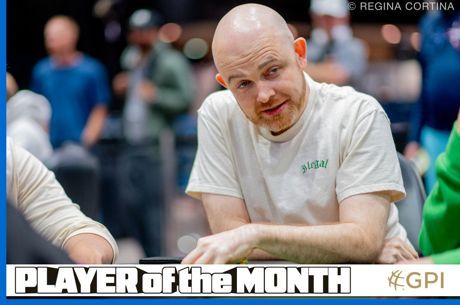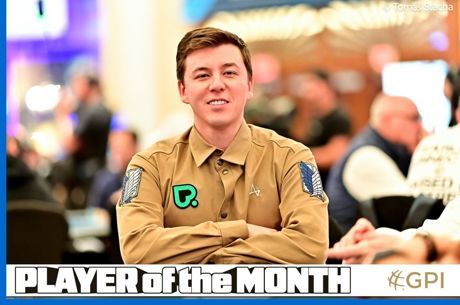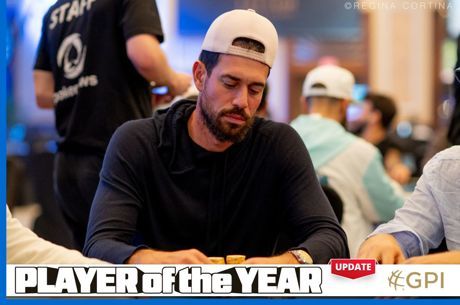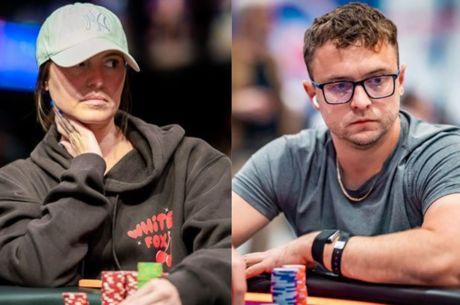Revolutionizing the Rankings: A Look at the Global Poker Index

Have you ever wondered: “Who are the best live tournament poker players in the world today?” Federated Sports + Gaming (FS+G) recently announced that it will attempt to answer that question with the creation of the Global Poker Index (GPI), a ranking system that will determine the top 300 live tournament poker players each and every week.
The GPI was developed by the commissioner of the Epic Poker League, Annie Duke, alongside FS+G’s CIO, Eric Faulkner, and a prominent authority in the blackjack world. PokerNews recently sat down with Duke to discuss the GPI, including its inception, the criteria, and what puts it above other ranking systems that have characterized the poker industry in years past (We’ve tried to cut down on the mathematical jargon, but if you’re interested in that sort of thing you can visit GlobalPokerIndex.com for all the technical details).
The GPI, which is patent pending, was not conceived overnight. In fact, it has been in the works for quite some time. As Duke explained: “I’ve always had some issues with the ranking systems that are out there, so I decided, ‘Well, if you want to do this, do it yourself.’ So we started working on this, me and Eric Faulkner, who is the co-creator, and we brought Don Schlesinger in as a consultant, he’s an amazing guy and very famous in the blackjack world. He’s currently [Chief Strategy Officer of The Volatility Exchange], and I thought that makes a lot of sense in poker because those are very similar worlds. So if we have someone who is really a statistician and an expert in that kind of world now bringing their expertise over here [to the poker world], with the expertise of the poker world that I was bringing to the table, I thought that would be an interesting combination to bring to the table in thinking outside the box in what a rank is supposed to be.”
According to its website, GPI players will be ranked “based on their performance by finishing in cash positions in qualifying tournaments occurring over the previous 36 month period . . . Each player’s individual GPI score is an aggregate of scores in events over the previous 36 month period, measured from the day the GPI is calculated. The score for a given event is derived from a combination of their finishing place percentage, buy-in and aging factor.”
With the help of Duke, PokerNews explored each of the three aforementioned factors in a little more detail.
Finishing Percentage Factor
The first of three factors, finishing percentage refers to amount of players someone defeats before their own elimination. In traditional ranking systems, finishing place is scored as a “static base score,” which then factors in multipliers such as field size, buy-in, etc.; however, there seems to be a serious flaw in such systems, being that the base score difference never changes.
As Duke put it: “If I’m in a 50-man tournament and I come in first and you come in second, that’s a much greater difference in accomplishment than if I’m in a 10,000-man tournament and I come in first and you come in second. It seemed that needed to be handled in a different way because in a 10,000-man tournament, first and second were relatively statistically identical results; whereas, in a 50-man tournament they’re not identical at all. You should be able to reflect that in some way. So what we did is, instead of taking a base score for finishing place, we’re going to handle it as a finishing percentage. So what we look at is the percentage of the field this player has beaten to come in this place.”
What does this mean in layman’s terms? Simply put, it means the difference in points awarded between each finishing place will depend on the number of entrants. The bigger the field, the lower the percentage changes between base score, say first and second, and vice versa.
Quick Hits on Finishing Percentage Factor
- A field size cap is applied at 2,500 entrants (the 99th percentile of qualifying events) so larger events don’t skew the GPI rankings. So, if an event draws 9,000 players, it will still be scored as a 2,500-player event.
- The cap will be reviewed once a year and can change if the 99th percentile number happens to have increased/decreased.
Buy-In Factor
When it comes to poker tournaments, some are clearly tougher than others. No one would argue that the $50,000 Poker Players Championship, which draws less than 150 players, is an easier field than say a $1,000 no-limit hold'em event at the World Series of Poker. “We needed something with a difficulty score, but we don’t have an entrants list for all the tournaments in the world, so we have to figure out what’s gonna give us an idea of what the most difficult tournaments are," said Duke. "I think the poker community would generally agree that the higher the buy-in, the more difficult the tournament.”
She went on to point out that the GPI scores difficulty by using a sublinear multiplier applied to buy-in, which is a logarithmic function, anchored at $1,500 buy-in events. Translation: the higher the buy-in, the more points you'll earn for your finish but there are diminishing returns as buy-in increases.
As the GPI site explains: “Other scoring systems do not fully take into account the concept of diminishing returns on the buy-in to an event. The percentage increase in buy-in between a $1,500 and $2,000 event is much greater than the increase between a $20,000 and a $20,500 buy-in. The GPI seeks to capture this concept of diminishing returns by using a logarithmic function.”
Quick Hits on the Buy-In Factor
- A buy-in cap is applied at $25,000 (the 99th percentile of qualifying events) so pricier events don’t skew the GPI rankings. That means next year’s $1 million buy-in tournament at the World Series of Poker will be scored as any other $25,000 High Roller tournament.
- Qualifying tournaments are events with 21 or more players and a buy-in of $1,500 USD (or other currency equivalent) or higher that is open to the public, and is not specialty or selected audience events such as charity, seniors, doubles, satellite, women, team, employee, executive and CEO events.
- Like the finishing place criteria, the cap will be reviewed once a year and can change if the 99th percentile number happens to have increased/decreased.
Aging Factor
When it comes to ranking players, it’s hard to not consider recent accomplishments in the criteria, which is a point the GPI assigns tremendous weight. As they say: “Aging factor refers to the weighting of results by their recency, where more recent results are weighted more heavily than past results.”
In order to accomplish this, the GPI will calculate their rankings based upon a 36 month aggregation period, which is broken down into six different periods consisting of six months each. The GPI will then take each player’s top three results from each of those periods and use them in their calculations.
For example, if a player finished first, third, fifth, eighth, and ninth in various tournaments between May and July, only the best three finishes would count in their GPI. All told, 18 results will be used in compiling an individual player’s ranking; however, that ranking will constantly change as players either add results or have past results fall outside the 36-month window, in essence falling off the back end into oblivion.
Aging Factors
- Period 1 (0-6 months) - 3.0 multiplier
- Period 2 (7 to 12 months) - 2.25 multiplier
- Period 3 (13-18 months) - 1.2 multiplier
- Period 4 (19 to 24 months) - 0.6 multiplier
- Period 5 (25 to 30 months) - 0.25 multiplier
- Period 6 (31 to 36 months) - 0.25 multiplier
“This is a really interesting time of year,” Duke said. “If you think about it, when the WSOP starts, somebody’s WSOP results from last year would be [in Period 2], so they’d get a multiplier of 2.25, but as soon as the WSOP ends, [those same results would now fall into Period 3] and get multiplied by 1.2.”
This was perfectly exampled by the first two weeks of the GPI when Daniel Negreanu was in sixth place last week, only to drop to 12th in this week’s rankings. Why did he drop so far in just a week? The reason is twofold. First, a few players had some big results to move ahead of him. Second, some of his results, namely those from the 2009 WSOP, either dropped off the back end of the 36-month window or moved into a lower period, meaning the multiplier was lowered.
Duke also stressed how important it was for the GPI to avoid rewarding players for outdated accomplishments and playing a high volume of tournaments, a pitfall she feels permeates other ranking systems. To combat this, the GPI limits the number of scores that will be counted at three, as previously mentioned. Why three? Duke explained: “We don’t want to be overly rewarding people who just play a lot of tournaments, because then you really get into that world where somebody could have a lot of money and playing volume while actually having a negative return on investment, but still be tracking very high in a system. So what we did is say that we wanted to apply some sort of cap.”
To determine that cap, the GPI turned to the Epic Poker League’s cardholders to find out the average number of cashes per player over a six-month period. “What we did was ask, ‘What’s the average number of times a player cashes per period?’ It turns out it’s in between two and three per six month period, so we said we’ll give them credit for three scores and rounded up.”
By only looking at three results per period, the GPI eliminates the benefits usually associated with playing a large volume of tournaments. A good example of someone who has benefited in the rankings by playing a high volume and with no age factor is Sorel Mizzi. On one major poker rankings list, Mizzi is ranked third with 1,297.11 points, even though he has managed five small cashes in the past seven months. While Mizzi had a tremendous 2010, earning 1,777.77 player-of-the-year points (that scoring formula awards half a power point per 2010 POY point), this year has been anything but exceptional, earning just 168.38 points so far in 2011. Nonetheless, Mizzi is still listed ahead of players such as Sam Stein, Bertrand Grospellier, John Juanda, Phil Hellmuth, and Fabrice Soulier, all of whom have been tearing up the tournament scene as of late.
What to Expect
The GPI has positioned itself to become a worldwide leader in poker rankings. In fact, we at PokerNews have given it our endorsement as the premier rankings in poker. In addition, the GPI’s weekly ranking will not only appear on EpicPoker.com, GlobalPokerIndex.com and PokerNews.com, but on USAToday.com, as well, no doubt going a long way in helping legitimize the game and bring it into the mainstream public spotlight.
To compliment its ranking system, GPI has its eyes set on even more applications and interactive tools. Duke herself professed a desire to develop the site to allow for historical comparisons. For example, how would Phil Hellmuth’s highest GPI ranking compare to Jason Mercier’s recent run? Who was better: Phil Ivey or Stu Ungar? Likewise, how do the top European players compare to the top U.S. players? Where do Brazilians, Russians, and Canadians fall? These are the sort of questions Duke believes the GPI will be able to address in due time.
While such features are in the works the GPI will be put to immediate use by providing the Epic Poker League seeding information for an upcoming heads-up tournament, which will mark the first time that a poker event has used rankings to determine their match-ups (think NFL Playoff seeding but in a heads-up poker tournament).
Obviously the GPI is in its infancy stage, but thanks to Duke and the people at FS+G, it seems to have a solid foundation set firmly in mathematics. Preliminary indications suggest that they’ve adopted a successful formula, both for their rankings and the future of the GPI.
If you want to keep tabs on the GPI, you might want to visit its Twitter and Facebook page. In the meantime, have a look at the latest GPI Top Ten list. As you can see based upon the names at the top of the list, the GPI is clearly getting it right!
The Top 10 as of July 11, 2011
| Rank | Player | Total Score |
|---|---|---|
| 1 | Jason Mercier | 2,459.89 |
| 2 | Bertrand “ElkY” Grospellier | 2,446.83 |
| 3 | Eugene Katchalov | 2,350.38 |
| 4 | Samuel Stein | 2,157.85 |
| 5 | Fabrice Soulier | 2,097.41 |
| 6 | Sorel Mizzi | 2,097.41 |
| 7 | Thomas Marchese | 2,023.70 |
| 8 | Tobias Reinkemeier | 2,017.54 |
| 9 | John Juanda | 2,013.63 |
| 10 | Vanessa Selbst | 2,011.05 |
To keep on top of all the latest in the poker world, including the GPI, FS+G, and Epic Poker League, be sure to follow us on Twitter and like us on Facebook!









